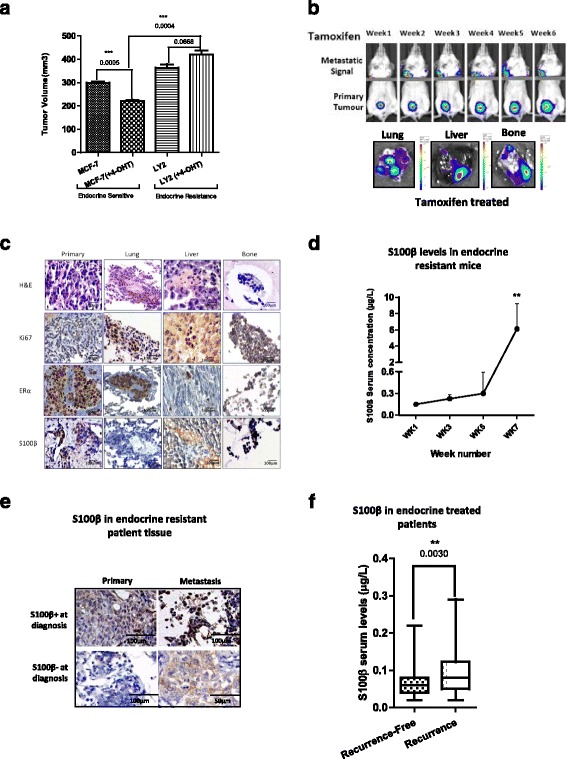Fig. 3.

Metastasis forms in resistant breast cancer in vivo which is marked by S100β. a Endocrine sensitive MCF-7 and endocrine resistant LY2 cells were injected into the mammary fat pad of 6-week-old Balbc/SCID mice. Mice were treated with estrogen and with or without slow release tamoxifen pellets. Tumor volume was decreased significantly in the endocrine sensitive model with tamoxifen treatment (p = 0.0005, n = 3), and there was a small, but not significant, increase in tumor volume in the endocrine resistant model with tamoxifen treatment compared to the untreated endocrine resistant model (p = 0.068, n = 3). There was also a significant increase in tumor volume with tamoxifen treatment in the endocrine sensitive compared to endocrine resistant model (p = 0.0004, n = 3). b Metastasis was formed in the presence of tamoxifen treatment at week 2 which increased gradually until the experimental endpoint. Metastasis was visualized and quantified using in vivo and ex vivo IVIS imaging at the experimental endpoint (week 7). c Formation of metastasis in the organs was confirmed at experimental endpoint (week 7) by immunohistochemical (IHC) analysis. Representative images of primary tissue, lung, liver, and bone. H&E staining demonstrated the presence of tumor epithelial cells in the metastatic sites, and nuclear Ki67 indicated active proliferation. ERα expression was maintained throughout the experiment in the primary tumor and in the lungs, liver, and bone metastases and S100β expression in primary tissue, lung, liver, and bone. (Representative image n = 7.) d S100β levels in the serum of mice treated with tamoxifen increased concurrently with metastasis (non-parametric t test of blood between weeks 5 and 7, p = 0.0012). e In matched patients who recurred on endocrine therapy high expression of S100β in their primary tumor was maintained in metastatic tissue, while patients with low S100β in their primary tumor gained expression of S100β in their metastatic tissue at diagnosis as determined by IHC analysis (n = 4). f Post-operative monitoring levels of S100β was significantly higher in patients with metastatic disease (n = 96 Recurrence-Free and n = 22 Recurrence patients; error bars refer to 95% CI, p = 0.003)
